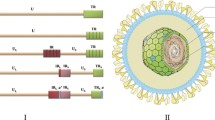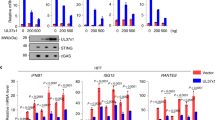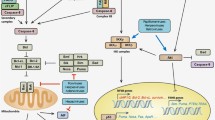Abstract
Cytomegaloviruses (CMVs) are large double-stranded DNA viruses that replicate slowly and cause life-long persisting infections in their hosts. To achieve this, the CMVs had to evolve numerous countermeasures against innate and adaptive immune responses. Induction of programmed cell death is one important host defense mechanism against intracellular pathogens such as viruses. For a multicellular organism, it is advantageous to let infected cells die in order to thwart viral replication and dissemination. For a virus, by contrast, it is better to inhibit cell death and keep infected cells alive until the viral replication cycle has been completed. As a matter of fact, the CMVs encode a number of proteins devoted to interfering with different forms of programmed cell death: apoptosis and necroptosis. In this review, we summarize the known functions of the four best characterized cell death inhibitors of murine cytomegalovirus (MCMV), which are encoded by open reading frames, M36, m38.5, m41.1, and M45. The viral proteins interact with key molecules within different cell death pathways, namely caspase-8, Bax, Bak, and RIP1/RIP3. In addition, we discuss which events during MCMV infection might trigger apoptosis or necrosis and how MCMV’s countermeasures compare to those of other herpesviruses. Since both, MCMV and its natural host, are amenable to genetic manipulation, the mouse model for CMV infection provides a particularly suitable system to study mechanisms of cell death induction and inhibition.



Similar content being viewed by others
References
Cannon MJ, Schmid DS, Hyde TB (2010) Review of cytomegalovirus seroprevalence and demographic characteristics associated with infection. Rev Med Virol 20(4):202–213
Cheung TW, Teich SA (1999) Cytomegalovirus infection in patients with HIV infection. Mt Sinai J Med 66(2):113–124
Steininger C (2007) Clinical relevance of cytomegalovirus infection in patients with disorders of the immune system. Clin Microbiol Infect 13(10):953–963
Grosse SD, Ross DS, Dollard SC (2008) Congenital cytomegalovirus (CMV) infection as a cause of permanent bilateral hearing loss: a quantitative assessment. J Clin Virol 41(2):57–62
Sung H, Schleiss MR (2010) Update on the current status of cytomegalovirus vaccines. Expert Rev Vaccines 9(11):1303–1314
Lurain NS, Chou S (2010) Antiviral drug resistance of human cytomegalovirus. Clin Microbiol Rev 23(4):689–712
Hudson JB (1979) The murine cytomegalovirus as a model for the study of viral pathogenesis and persistent infections. Arch Virol 62(1):1–29
Sinclair J, Sissons P (2006) Latency and reactivation of human cytomegalovirus. J Gen Virol 87(Pt 7):1763–1779
Galluzzi L et al (2012) Molecular definitions of cell death subroutines: recommendations of the Nomenclature Committee on Cell Death 2012. Cell Death Differ 19(1):107–120
Kroemer G et al (2009) Classification of cell death: recommendations of the Nomenclature Committee on Cell Death 2009. Cell Death Differ 16(1):3–11
Barnhart BC, Alappat EC, Peter ME (2003) The CD95 type I/type II model. Semin Immunol 15(3):185–193
Scaffidi C et al (1998) Two CD95 (APO-1/Fas) signaling pathways. EMBO J 17(6):1675–1687
Thorburn A (2004) Death receptor-induced cell killing. Cell Signal 16(2):139–144
Skaletskaya A et al (2001) A cytomegalovirus-encoded inhibitor of apoptosis that suppresses caspase-8 activation. Proc Natl Acad Sci USA 98(14):7829–7834
Menard C et al (2003) Role of murine cytomegalovirus US22 gene family members in replication in macrophages. J Virol 77(10):5557–5570
McCormick AL et al (2003) Differential function and expression of the viral inhibitor of caspase 8-induced apoptosis (vICA) and the viral mitochondria-localized inhibitor of apoptosis (vMIA) cell death suppressors conserved in primate and rodent cytomegaloviruses. Virology 316(2):221–233
Cicin-Sain L et al (2008) Dominant-negative FADD rescues the in vivo fitness of a cytomegalovirus lacking an antiapoptotic viral gene. J Virol 82(5):2056–2064
Norris KL, Youle RJ (2008) Cytomegalovirus proteins vMIA and m38.5 link mitochondrial morphogenesis to Bcl-2 family proteins. J Virol 82(13):6232–6243
Jurak I et al (2008) Murine cytomegalovirus m38.5 protein inhibits Bax-mediated cell death. J Virol 82(10):4812–4822
Arnoult D et al (2008) The murine cytomegalovirus cell death suppressor m38.5 binds Bax and blocks Bax-mediated mitochondrial outer membrane permeabilization. Apoptosis 13(9):1100–1110
Manzur M et al (2009) Virally mediated inhibition of Bax in leukocytes promotes dissemination of murine cytomegalovirus. Cell Death Differ 16(2):312–320
Cam M et al (2010) Cytomegaloviruses inhibit Bak- and Bax-mediated apoptosis with two separate viral proteins. Cell Death Differ 17(4):655–665
McCormick AL et al (2005) Mitochondrial cell death suppressors carried by human and murine cytomegalovirus confer resistance to proteasome inhibitor-induced apoptosis. J Virol 79(19):12205–12217
Goldmacher VS et al (1999) A cytomegalovirus-encoded mitochondria-localized inhibitor of apoptosis structurally unrelated to Bcl-2. Proc Natl Acad Sci USA 96(22):12536–12541
Goldmacher VS (2005) Cell death suppression by cytomegaloviruses. Apoptosis 10(2):251–265
Arnoult D et al (2004) Cytomegalovirus cell death suppressor vMIA blocks Bax- but not Bak-mediated apoptosis by binding and sequestering Bax at mitochondria. Proc Nat Acad Sci USA 101(21):7988–7993
Poncet D et al (2004) An anti-apoptotic viral protein that recruits Bax to mitochondria. J Biol Chem 279(21):22605–22614
Festjens N, Vanden Berghe T, Vandenabeele P (2006) Necrosis, a well-orchestrated form of cell demise: signalling cascades, important mediators and concomitant immune response. Biochim Biophys Acta 1757(9–10):1371–1387
Vandenabeele P et al (2010) Molecular mechanisms of necroptosis: an ordered cellular explosion. Nat Rev Mol Cell Biol 11(10):700–714
Vandenabeele P et al (2010) The role of the kinases RIP1 and RIP3 in TNF-induced necrosis. Sci Signal 3(115):e4
Goossens V et al (1999) Regulation of tumor necrosis factor-induced, mitochondria- and reactive oxygen species-dependent cell death by the electron flux through the electron transport chain complex I. Antioxid Redox Signal 1(3):285–295
Zhang DW et al (2009) RIP3, an energy metabolism regulator that switches TNF-induced cell death from apoptosis to necrosis. Science 325(5938):332–336
Feoktistova M et al (2011) cIAPs block Ripoptosome formation, a RIP1/caspase-8 containing intracellular cell death complex differentially regulated by cFLIP isoforms. Mol Cell 43(3):449–463
Kaiser WJ, Offermann MK (2005) Apoptosis induced by the toll-like receptor adaptor TRIF is dependent on its receptor interacting protein homotypic interaction motif. J Immunol 174(8):4942–4952
Rebsamen M et al (2009) DAI/ZBP1 recruits RIP1 and RIP3 through RIP homotypic interaction motifs to activate NF-kappaB. EMBO Rep 10(8):916–922
Upton J, K.W.a.M. E. (2012) DAI/ZBP1/DLM-1 Complexes with RIP3 to mediate virus-induced programmed necrosis that is targeted by murine cytomegalovirus vIRA. Cell Host Microbe 11(3)
Brune W et al (2001) A ribonucleotide reductase homolog of cytomegalovirus and endothelial cell tropism. Science 291(5502):303–305
Lembo D et al (2004) The ribonucleotide reductase R1 homolog of murine cytomegalovirus is not a functional enzyme subunit but is required for pathogenesis. J Virol 78(8):4278–4288
Mack C et al (2008) Inhibition of proinflammatory and innate immune signaling pathways by a cytomegalovirus RIP1-interacting protein. Proc Natl Acad Sci US A 105(8):3094–3099
Upton JW, Kaiser WJ, Mocarski ES (2008) Cytomegalovirus M45 cell death suppression requires receptor-interacting protein (RIP) homotypic interaction motif (RHIM)-dependent interaction with RIP1. J Biol Chem 283(25):16966–16970
Upton JW, Kaiser WJ, Mocarski ES (2010) Virus inhibition of RIP3-dependent necrosis. Cell Host Microbe 7(4):302–313
Fliss PM et al (2012) Viral mediated redirection of NEMO/IKKgamma to autophagosomes curtails the inflammatory cascade. PLoS Pathog 8(2):e1002517
Dutta J et al (2006) Current insights into the regulation of programmed cell death by NF-kappaB. Oncogene 25(51):6800–6816
Pichlmair A, Reis e Sousa C (2007) Innate recognition of viruses. Immunity 27(3):370–383
Maher SG et al (2007) Interferon: cellular executioner or white knight? Curr Med Chem 14(12):1279–1289
Brandstadter JD, Yang Y (2011) Natural killer cell responses to viral infection. J Innate Immun 3(3):274–279
Zahringer U et al (2008) TLR2—promiscuous or specific? A critical re-evaluation of a receptor expressing apparent broad specificity. Immunobiology 213(3–4):205–224
Boehme KW, Guerrero M, Compton T (2006) Human cytomegalovirus envelope glycoproteins B and H are necessary for TLR2 activation in permissive cells. J Immunol 177(10):7094–7102
Szomolanyi-Tsuda E et al (2006) Role for TLR2 in NK cell-mediated control of murine cytomegalovirus in vivo. J Virol 80(9):4286–4291
Aliprantis AO et al (2000) The apoptotic signaling pathway activated by Toll-like receptor-2. EMBO J 19(13):3325–3336
Aravalli RN, Hu S, Lokensgard JR (2007) Toll-like receptor 2 signaling is a mediator of apoptosis in herpes simplex virus-infected microglia. J Neuroinflammation 4:11
He S et al (2011) Toll-like receptors activate programmed necrosis in macrophages through a receptor-interacting kinase-3-mediated pathway. Proc Natl Acad Sci USA 108(50):20054–20059
Tabeta K et al (2004) Toll-like receptors 9 and 3 as essential components of innate immune defense against mouse cytomegalovirus infection. Proc Natl Acad Sci USA 101(10):3516–3521
Edelmann KH et al (2004) Does Toll-like receptor 3 play a biological role in virus infections? Virology 322(2):231–238
Takaoka A et al (2007) DAI (DLM-1/ZBP1) is a cytosolic DNA sensor and an activator of innate immune response. Nature 448(7152):501–505
Kaiser WJ, Upton JW, Mocarski ES (2008) Receptor-interacting protein homotypic interaction motif-dependent control of NF-kappa B activation via the DNA-dependent activator of IFN regulatory factors. J Immunol 181(9):6427–6434
Wu J, Fernandes-Alnemri T, Alnemri ES (2010) Involvement of the AIM2, NLRC4, and NLRP3 inflammasomes in caspase-1 activation by Listeria monocytogenes. J Clin Immunol 30(5):693–702
Miao EA, Rajan JV, Aderem A (2011) Caspase-1-induced pyroptotic cell death. Immunol Rev 243(1):206–214
Fernandes-Alnemri T et al (2009) AIM2 activates the inflammasome and cell death in response to cytoplasmic DNA. Nature 458(7237):509–513
Bergsbaken T, Fink SL, Cookson BT (2009) Pyroptosis: host cell death and inflammation. Nat Rev Microbiol 7(2):99–109
Rathinam VA et al (2010) The AIM2 inflammasome is essential for host defense against cytosolic bacteria and DNA viruses. Nat Immunol 11(5):395–402
Clemens MJ, Elia A (1997) The double-stranded RNA-dependent protein kinase PKR: structure and function. J Interferon Cytokine Res 17(9):503–524
Gil J, Esteban M (2000) Induction of apoptosis by the dsRNA-dependent protein kinase (PKR): mechanism of action. Apoptosis 5(2):107–114
Valchanova RS et al (2006) Murine cytomegalovirus m142 and m143 are both required to block protein kinase R-mediated shutdown of protein synthesis. J Virol 80(20):10181–10190
Budt M et al (2009) Specific inhibition of the PKR-mediated antiviral response by the murine cytomegalovirus proteins m142 and m143. J Virol 83(3):1260–1270
Child SJ, Geballe AP (2009) Binding and relocalization of protein kinase R by murine cytomegalovirus. J Virol 83(4):1790–1799
Szegezdi E et al (2006) Mediators of endoplasmic reticulum stress-induced apoptosis. EMBO Rep 7(9):880–885
Wek RC, Jiang HY, Anthony TG (2006) Coping with stress: eIF2 kinases and translational control. Biochem Soc Trans 34(Pt 1):7–11
Isler JA, Skalet AH, Alwine JC (2005) Human cytomegalovirus infection activates and regulates the unfolded protein response. J Virol 79(11):6890–6899
Xuan B et al (2009) Human cytomegalovirus protein pUL38 induces ATF4 expression, inhibits persistent JNK phosphorylation, and suppresses endoplasmic reticulum stress-induced cell death. J Virol 83(8):3463–3474
Qian Z et al (2012) Murine cytomegalovirus targets transcription factor ATF4 to exploit the unfolded-protein response. J Virol 86(12):6712–6723
Shiloh Y (2006) The ATM-mediated DNA-damage response: taking shape. Trends Biochem Sci 31(7):402–410
Shieh SY et al (2000) The human homologs of checkpoint kinases Chk1 and Cds1 (Chk2) phosphorylate p53 at multiple DNA damage-inducible sites. Genes Dev 14(3):289–300
Canman CE et al (1998) Activation of the ATM kinase by ionizing radiation and phosphorylation of p53. Science 281(5383):1677–1679
Yang Y et al (2011) A cytosolic ATM/NEMO/RIP1 complex recruits TAK1 to mediate the NF-kappaB and p38 mitogen-activated protein kinase (MAPK)/MAPK-activated protein 2 responses to DNA damage. Mol Cell Biol 31(14):2774–2786
Bock FJ et al (2012) P53-induced protein with a death domain (PIDD): master of puppets? Oncogene
Janssens S, Tinel A (2012) The PIDDosome, DNA-damage-induced apoptosis and beyond. Cell Death Differ 19(1):13–20
Gaspar M, Shenk T (2006) Human cytomegalovirus inhibits a DNA damage response by mislocalizing checkpoint proteins. Proc Natl Acad Sci USA 103(8):2821–2826
Shen YH et al (2004) Human cytomegalovirus causes endothelial injury through the ataxia telangiectasia mutant and p53 DNA damage signaling pathways. Circ Res 94(10):1310–1317
Dufour F et al (2011) The ribonucleotide reductase R1 subunits of herpes simplex virus types 1 and 2 protect cells against TNFalpha- and FasL-induced apoptosis by interacting with caspase-8. Apoptosis 16(3):256–271
Dufour F et al (2011) The ribonucleotide reductase R1 subunits of herpes simplex virus 1 and 2 protect cells against poly(I. C)-induced apoptosis. J Virol 85(17):8689–8701
Thome M et al (1997) Viral FLICE-inhibitory proteins (FLIPs) prevent apoptosis induced by death receptors. Nature 386(6624):517–521
Brooks C et al (2007) Bak regulates mitochondrial morphology and pathology during apoptosis by interacting with mitofusins. Proc Natl Acad Sci USA 104(28):11649–11654
Cartron PF et al (2003) Nonredundant role of Bax and Bak in Bid-mediated apoptosis. Mol Cell Biol 23(13):4701–4712
Neise D et al (2008) Activation of the mitochondrial death pathway is commonly mediated by a preferential engagement of Bak. Oncogene 27(10):1387–1396
Karbowski M et al (2006) Role of Bax and Bak in mitochondrial morphogenesis. Nature 443(7112):658–662
Cheng EH et al (1997) A Bcl-2 homolog encoded by Kaposi sarcoma-associated virus, human herpesvirus 8, inhibits apoptosis but does not heterodimerize with Bax or Bak. Proc Natl Acad Sci USA 94(2):690–694
Cheng G, Feng Z, He B (2005) Herpes simplex virus 1 infection activates the endoplasmic reticulum resident kinase PERK and mediates eIF-2alpha dephosphorylation by the gamma(1)34.5 protein. J Virol 79(3):1379–1388
Carpenter JE et al (2011) Autophagosome formation during varicella-zoster virus infection following endoplasmic reticulum stress and the unfolded protein response. J Virol 85(18):9414–9424
Qian Z et al (2011) The human cytomegalovirus protein pUL38 suppresses endoplasmic reticulum stress-mediated cell death independently of its ability to induce mTORC1 activation. J Virol 85(17):9103–9113
Brune W (2011) Inhibition of programmed cell death by cytomegaloviruses. Virus Res 157(2):144–150
Hicks SW, Machamer CE (2005) Golgi structure in stress sensing and apoptosis. Biochim Biophys Acta 1744(3):406–414
Lane JD et al (2002) Caspase-mediated cleavage of the stacking protein GRASP65 is required for Golgi fragmentation during apoptosis. J Cell Biol 156(3):495–509
Walker A et al (2004) Golgi fragmentation during Fas-mediated apoptosis is associated with the rapid loss of GM130. Biochem Biophys Res Commun 316(1):6–11
Mancini M et al (2000) Caspase-2 is localized at the Golgi complex and cleaves golgin-160 during apoptosis. J Cell Biol 149(3):603–612
Brune W, Nevels M, Shenk T (2003) Murine cytomegalovirus m41 open reading frame encodes a Golgi-localized antiapoptotic protein. J Virol 77(21):11633–11643
de Mattia F et al (2009) Human Golgi antiapoptotic protein modulates intracellular calcium fluxes. Mol Biol Cell 20(16):3638–3645
Gubser C et al (2007) A new inhibitor of apoptosis from vaccinia virus and eukaryotes. PLoS Pathog 3(2):e17
Nikitin PA et al (2010) An ATM/Chk2-mediated DNA damage-responsive signaling pathway suppresses Epstein-Barr virus transformation of primary human B cells. Cell Host Microbe 8(6):510–522
Wilkinson DE, Weller SK (2004) Recruitment of cellular recombination and repair proteins to sites of herpes simplex virus type 1 DNA replication is dependent on the composition of viral proteins within prereplicative sites and correlates with the induction of the DNA damage response. J Virol 78(9):4783–4796
Luo MH et al (2007) Human cytomegalovirus disrupts both ataxia telangiectasia mutated protein (ATM)- and ATM-Rad3-related kinase-mediated DNA damage responses during lytic infection. J Virol 81(4):1934–1950
Tuddenham L, Pfeffer S (2011) Roles and regulation of microRNAs in cytomegalovirus infection. Biochim Biophys Acta 1809(11–12):613–622
Suffert G et al (2011) Kaposi’s sarcoma herpesvirus microRNAs target caspase 3 and regulate apoptosis. PLoS Pathog 7(12):e1002405
Reeves MB et al (2007) Complex I binding by a virally encoded RNA regulates mitochondria-induced cell death. Science 316(5829):1345–1348
Brune W, Hengel H, Koszinowski UH (2001) A mouse model for cytomegalovirus infection. Curr Protoc Immunol Chapter 19, Unit 19 7
Guan C et al (2010) A review of current large-scale mouse knockout efforts. Genesis 48(2):73–85
Ruzsics Z, Koszinowski UH (2008) Mutagenesis of the cytomegalovirus genome. Curr Top Microbiol Immunol 325:41–61
Acknowledgments
The authors would like to thank Patricia Fliss for a critical reading of the manuscript. This work was supported by the German Research Foundation (BR 1730/3-1 to W.B.).
Conflict of interest
The authors declare that they have no conflict of interest.
Author information
Authors and Affiliations
Corresponding author
Additional information
Wiebke Handke and Eva Krause contributed equally to this work.
Rights and permissions
About this article
Cite this article
Handke, W., Krause, E. & Brune, W. Live or let die: manipulation of cellular suicide programs by murine cytomegalovirus. Med Microbiol Immunol 201, 475–486 (2012). https://doi.org/10.1007/s00430-012-0264-z
Received:
Accepted:
Published:
Issue Date:
DOI: https://doi.org/10.1007/s00430-012-0264-z




